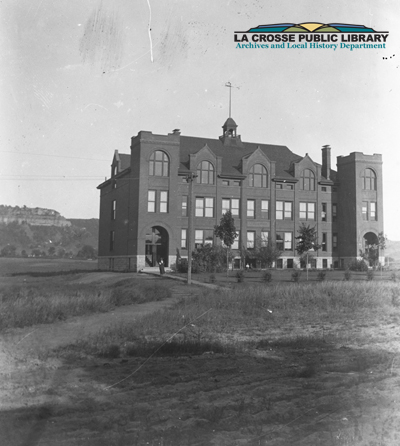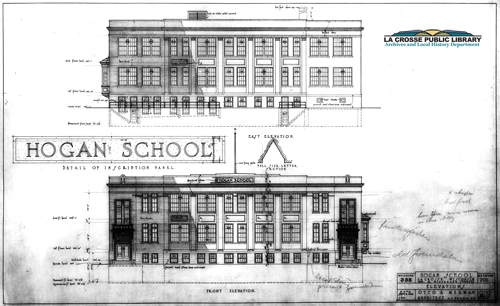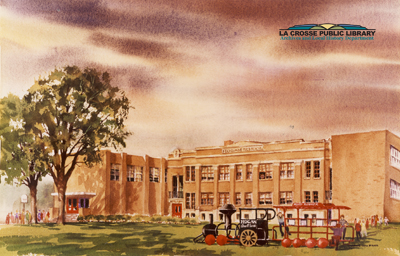
Growing Community Needed Hogan School
(written by David Kranz, Archives Staff)
From its roots along the shore of the Mississippi River, the city of La Crosse expanded westward toward the bluffs, filling in the broad sand prairie with residences. In 1899, East Avenue was the eastern edge for a portion of the city’s development.
With the spread of residential development and an increasing population came a need for a new school. A number of locations were discussed, but geography and the willingness of successful grocery wholesaler James J. Hogan to donate land for the a school resulted in the selection of a site between Mississippi and Winnebago Streets, and East Avenue and 19th Street.

This 1898 city atlas detail shows the area around what would become the Hogan School site, map modified to show the school site.
Ground was broken for the first Hogan School in September 1899, and the building was dedicated in April 1900. Designer was architect Hugo Schick, who applied Romanesque elements to the overall design. There were two floors of classrooms, a basement and a large unfinished room on the third floor that was considered likely space for an assembly hall. Large windows on east and west sides let in lots of light. Grades 1-4 were initially served at the school, with students required to attend for at least 12 weeks of the year. That would soon increase to a requirement of 32 weeks, and grade coverage would expand to K-6 in coming years.

The first Hogan School opened in 1900. As we can see, not many houses were located between here and the bluffs at the time. (Janice and Richard Snowberg Papers Relating to “History of Hogan School,” MSS 111, LPL Archives.)
One account says that pasque flowers grew abundantly on the open prairie spaces, suggesting they were a perhaps frequent gift from students to their teachers. Horses and farm animals would not have been unusual to see, and even a circus or two made use of the open space to set down stakes for a bit.

Pasque flowers are early spring bloomers and wild examples can still be seen on the bluffs and other undeveloped spaces around La Crosse. (Erin Hoy photo, taken April 10, 2016, near Miller Bluff.)
In June of 1920, two days before school was to let out for the summer, lightning struck the school and started a fire. Fire fighters responded, but water pressure was so weak at these ends of the water mains that their spray could only reach the second floor. The fire raged, leaving the building a roofless shell and displacing Hogan School’s 290 students and eight teachers.
The fire started on June 9. By June 11, architect Otto Merman was working on plans for barracks-style temporary school structures that would be placed on a lot near 16th and Winnebago Streets for use during the 1920-1921 school year.
By September of 1920 Merman had plans completed and approved for a second Hogan School, which would become the core of the Hogan building we can view today. Using the footprint of the first school, Merman designed a two-story schoolhouse of brick and limestone with gymnasium in the basement. Several of Merman’s plans are available for viewing on microfilm at the LPL Archives.

Architect Otto Merman’s September 1920 exterior designs for the second Hogan School building with oriel window sticking out on the south wall. (Bentley, Merman, and Skogstad Architectural Drawings, MSS 070, LPL Archives.)
Initially, Winnebago Street continued along the north side of the Hogan School property. In 1921, the school acquired the block to the north, between Winnebago and Market Streets, and closed off Winnebago Street. The space to the north was used as a playground and activity space. The ground on that northern block had a natural depression that could be flooded for ice skating in the winter but that in spring would turn in to a muddy scrum, not great for a school play area. In 1955 various concrete waste materials and fill were used to level it. Improvements were made with the assistance of the Hogan School Parent-Teacher Association; features included a baseball diamond, a broad jump landing pit and a horizontal telephone pole for vaulting.
With the baby boom after World War II, an uptick in school-age children resulted in a need for more school space. Two wing additions were created on the north and south ends of Hogan School, approved in 1948 and dedicated in 1950. A cornerstone was laid in 1949 with pictures and documents inside.

The south wing addition to Hogan School was ready to use by the 1949-1950 school year, a few months before the north wing was completed. (La Crosse Tribune, Aug. 14, 1949.)
For the first half of its existence, active train tracks ran north-south in front of Hogan School. In the mid-1950s, the tracks went out of service and were dismantled. In homage to this history, in the early 1970s when an effort was made to improve school playgrounds, a “Hogan Short Line” engine and caboose play structure was installed.

This painting of the school was made by Marion Biehn. (Janice and Richard Snowberg Papers Relating to “History of Hogan School,” MSS 111, LPL Archives.)
Active use of the Hogan School as a school was ended in the 1980s, though in recent years individual classes such as the 7 Rivers Community High School have made use of some of the space. For several years the building has housed the School District of La Crosse’s administrative offices. There has been talk about moving students back into the Hogan building.
We can present much of this history of Hogan School because someone gathered it up and donated it to the LPL Archives. When the school was slated for closure in 1980, the Hogan School PTA decided to create a booklet about the school’s history. Information was compiled by Janice Snowberg with help from Richard Snowberg. The work was published as a booklet called “History of Hogan School,” and their supporting newspaper articles, pictures, and other items were given to the Archives.
Additionally, while preparing the booklet, Snowberg recorded oral histories with 27 former teachers and students, some whose time as students dated back to the first Hogan School building. You can see the booklet and listen to these oral histories at the LPL Archives. (More detailed information about these holdings is available here)

